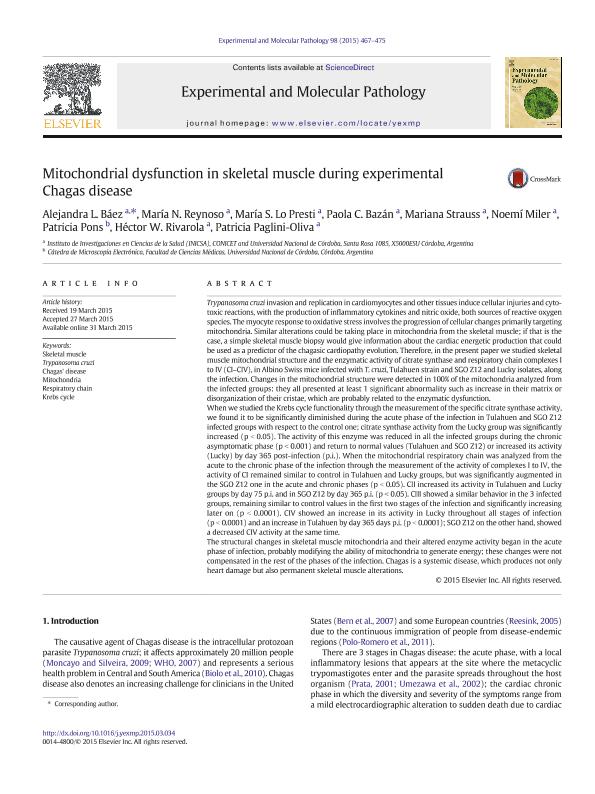Artículo
Mitochondrial dysfunction in skeletal muscle during experimental Chagas disease
Báez, Alejandra Lidia ; Reynoso, Mercedes María Noel
; Reynoso, Mercedes María Noel ; Lo Presti, Maria Silvina
; Lo Presti, Maria Silvina ; Bazán, Paola Carolina
; Bazán, Paola Carolina ; Strauss, Mariana
; Strauss, Mariana ; Miler, Noemí del Carmen; Pons, Patricia; Rivarola, Hector Walter; Paglini, Patricia Adriana
; Miler, Noemí del Carmen; Pons, Patricia; Rivarola, Hector Walter; Paglini, Patricia Adriana
 ; Reynoso, Mercedes María Noel
; Reynoso, Mercedes María Noel ; Lo Presti, Maria Silvina
; Lo Presti, Maria Silvina ; Bazán, Paola Carolina
; Bazán, Paola Carolina ; Strauss, Mariana
; Strauss, Mariana ; Miler, Noemí del Carmen; Pons, Patricia; Rivarola, Hector Walter; Paglini, Patricia Adriana
; Miler, Noemí del Carmen; Pons, Patricia; Rivarola, Hector Walter; Paglini, Patricia Adriana
Fecha de publicación:
06/2015
Editorial:
Academic Press Inc Elsevier Science
Revista:
Experimental and Molecular Pathology
ISSN:
0014-4800
e-ISSN:
1096-0945
Idioma:
Inglés
Tipo de recurso:
Artículo publicado
Clasificación temática:
Resumen
Trypanosoma cruzi invasion and replication in cardiomyocytes and other tissues induce cellular injuries and cytotoxic reactions, with the production of inflammatory cytokines and nitric oxide, both sources of reactive oxygen species. The myocyte response to oxidative stress involves the progression of cellular changes primarily targeting mitochondria. Similar alterations could be taking place in mitochondria from the skeletal muscle; if that is the case, a simple skeletal muscle biopsy would give information about the cardiac energetic production that could be used as a predictor of the chagasic cardiopathy evolution. Therefore, in the present paper we studied skeletal muscle mitochondrial structure and the enzymatic activity of citrate synthase and respiratory chain complexes I to IV (CI–CIV), in Albino Swiss mice infected with T. cruzi, Tulahuen strain and SGO Z12 and Lucky isolates, along the infection. Changes in the mitochondrial structure were detected in 100% of the mitochondria analyzed from the infected groups: they all presented at least 1 significant abnormality such as increase in their matrix or disorganization of their cristae, which are probably related to the enzymatic dysfunction. When we studied the Krebs cycle functionality through the measurement of the specific citrate synthase activity, we found it to be significantly diminished during the acute phase of the infection in Tulahuen and SGO Z12 infected groups with respect to the control one; citrate synthase activity from the Lucky group was significantly increased (p b 0.05). The activity of this enzyme was reduced in all the infected groups during the chronic asymptomatic phase (p b 0.001) and return to normal values (Tulahuen and SGO Z12) or increased its activity (Lucky) by day 365 post-infection (p.i.). When the mitochondrial respiratory chain was analyzed from the acute to the chronic phase of the infection through the measurement of the activity of complexes I to IV, the activity of CI remained similar to control in Tulahuen and Lucky groups, but was significantly augmented in the SGO Z12 one in the acute and chronic phases (p b 0.05). CII increased its activity in Tulahuen and Lucky groups by day 75 p.i. and in SGO Z12 by day 365 p.i. (p b 0.05). CIII showed a similar behavior in the 3 infected groups, remaining similar to control values in the first two stages of the infection and significantly increasing later on (p b 0.0001). CIV showed an increase in its activity in Lucky throughout all stages of infection (p b 0.0001) and an increase in Tulahuen by day 365 days p.i. (p b 0.0001); SGO Z12 on the other hand, showed a decreased CIV activity at the same time. The structural changes in skeletal muscle mitochondria and their altered enzyme activity began in the acute phase of infection, probably modifying the ability of mitochondria to generate energy; these changes were not compensated in the rest of the phases of the infection. Chagas is a systemic disease, which produces not only heart damage but also permanent skeletal muscle alterations.
Archivos asociados
Licencia
Identificadores
Colecciones
Articulos(INICSA)
Articulos de INSTITUTO DE INVESTIGACIONES EN CIENCIAS DE LA SALUD
Articulos de INSTITUTO DE INVESTIGACIONES EN CIENCIAS DE LA SALUD
Citación
Báez, Alejandra Lidia; Reynoso, Mercedes María Noel; Lo Presti, Maria Silvina; Bazán, Paola Carolina; Strauss, Mariana; et al.; Mitochondrial dysfunction in skeletal muscle during experimental Chagas disease; Academic Press Inc Elsevier Science; Experimental and Molecular Pathology; 98; 3; 6-2015; 467-475
Compartir
Altmétricas



